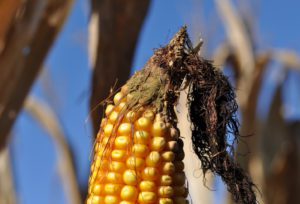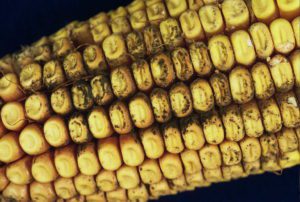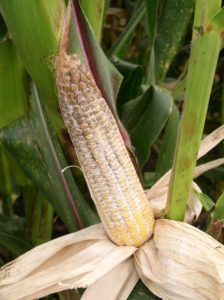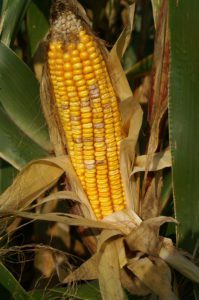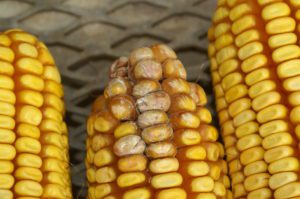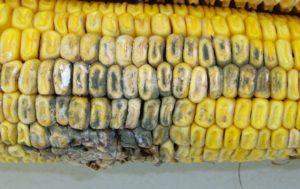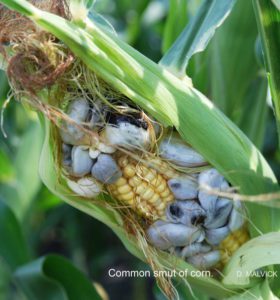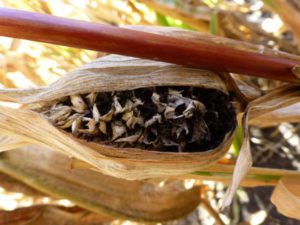Corn ear molds can lead to yield loss at harvest. If mycotoxins are present, such as with aspergillus and fusarium molds, the grain may be toxic to animals and unusable.
- Scout for ear molds beginning at late-dent stage. Choose ears from throughout your field, pull husks back and examine each ear for rot or mold.
- To identify a disease, consider conditions in which the crop was planted, field history, husk type, and environmental conditions at tasseling, silking, and pollination.
- If you can’t identify the ear mold, send the entire ear to an agronomist or university agriculture extension for evaluation.
- Moldy grain should not be stored. Grain intended for livestock feed should be tested for mycotoxins, which make it unsafe to use.
- Plan ahead to avoid ear mold development next season. Rotating crops and planting a hybrid with ear rot resistance can lessen the chance of developing ear molds. Hybrids with in-plant insect protection can reduce insect damage to help prevent diseases from entering the ear.
Aspergillus
Aspergillus ear rot is one of the most important diseases of corn. It is caused primarily by the fungus Aspergillus flavus, but a few other Aspergillus species may be involved. The Aspergillus fungus survives in soil or crop residue and infects ears during late silking. Spores are spread by wind and insects and infection takes place through insect wounds or other types of wounds or through the silks. Hot, dry conditions favor infection. Stressed plants (from nutrient deficiencies, drought, or feeding damage from ear-invading insects) are often more susceptible to this disease. Scouting prior to physiological maturity is important to identify areas with mold problems. These areas should be harvested as soon as possible to prevent further mold development. Harvested grain should be cooled, dried, and cleaned immediately after harvest, and stored apart from grain harvested from healthy fields. Insect management reduces the risk of ear rot infection.
- More common in the southern US
- Olive-green mold that may begin at the tip of the ear
- May be associated with injury from insects, birds, or hail
- Fungal spores appear powdery and may disperse like dust when you pull back the husk
- Produces a mycotoxin called aflatoxin
- Kernels with no visible injury or mold may still contain aflatoxin
For more information on Aspergillus, the Crop Protection Network has multiple publications available: Ear Rots, Using Atoxigenics to Manage Aflatoxin, and Mycotoxin FAQs.
Cladosporium
Cladosporium ear rot is caused by the fungus Cladosporium herbarum. This ear rot is often associated with hail, frost, or insect injury and is favored by wet weather during grain fill. It is more common in hot, dry years in the northern Corn Belt and can grow at temperatures higher than 90°F and grain moisture content as low as 16 percent.
- More common in hot, dry years in northern Corn Belt
- Appears as dark green or black powdery mold and black streaks on kernels
- Dark green, fuzzy mold may also be observed on and between kernels
- Associated with hail, frost or insect injury
- Favored by wet weather during grain fill
- No associated mycotoxins
For more information on Cladosporium, visit the Crop Protection Network or view their Ear Rots publication.
Diplodia
Diplodia ear rot is caused by the fungus Stenocarpella maydis and S. macrospora and has become a common (and troublesome) disease on corn. These fungi produce mycotoxins in South America and Africa, but no mycotoxins have been associated with Diplodia ear rot in the United States and Canada. The fungus overwinters as mycelium, spores, and pycnidia on corn residue or seed. Spores are spread primarily by splashing rain. Dry weather before silking, immediately followed by wet conditions, favors Diplodia ear rot as does conservation tillage, continuous corn, and hybrid susceptibility. Delayed harvest and wet weather before harvest can allow fungal growth to continue, further reducing grain quality and yield.
- White mold beginning at the ear base
- Eventually becomes grayish-brown and rots entire ear
- Ear leaves die prematurely on infected ears
- Entire husk often appears bleached
- Distinguished by raised black bumps (pycnidia) on moldy husk or kernels
- No associated mycotoxins in US
For more information on Diplodia, visit the Crop Protection Network or view their Ear Rots and Mycotoxin FAQs publications.
Fusarium
Fusarium ear rot is the most common ear disease, caused by several fungi in the genus Fusarium. Causal fungi overwinter in corn residue and on dead, grassy weeds. Fusarium spores are spread by wind and splashing rain to silks. Infections also occur through wounds made by insects or other types of wounds in kernels. Insects also act as vectors of Fusarium. F. verticillioides can grow throughout the corn plant, and some ear infections may result from the fungus entering the ear through the stalk. Disease is favored by hot and dry weather during and after silking. Several Fusarium species causing ear rot also can produce harmful mycotoxins, so caution should be used when feeding moldy corn to animals. Moldy corn should be tested for mycotoxin contamination prior to feeding. Scouting prior to physiological maturity is important to identify areas with mold problems. These areas should be harvested as soon as possible to prevent further mold development. Harvested grain should be cooled, dried, and cleaned immediately after harvest, and stored apart from grain harvested from healthy fields. Insect management reduces the risk of ear rot infection.
- Most common ear disease
- White to pink or salmon-colored, cottony mold occurs on single or multiple kernels scattered or clustered on the ear
- Decay begins with insect damage
- Fusarium spores are spread by wind and splashing rain
- Favored by hot and dry weather during and after silking
- Produces mycotoxin called fumonisins
For more information on Fusarium, visit the Crop Protection Network or view their Ear Rots and Mycotoxin FAQs publications.
Gibberella
Gibberella ear rot is caused by the fungus Gibberella zeae. It is a consistently important mycotoxigenic fungus in the northern Corn Belt, producing vomitoxin, zearalenone, and other toxins. Excessive mold may cause silks and husks to adhere to the ear. In severe cases, the pink mold is visible on the outside of the husks at the ear tip. This ear rot is common, particularly when conditions are cool and wet during grain fill.
- Produces vomitoxin, zearalenone and other toxins
- Red or pink colored mold that begins at the tip of the ear
- Excessive mold causes silks and husks to adhere to the ear
- Fungus overwinters in corn residue
- Common when conditions are cool and wet during grain fill
For more information on Gibberella, visit the Crop Protection Network or view their Ear Rots and Mycotoxin FAQs publications.
Penicillium
Penicillium ear rot is caused by multiple Penicillium spp. It is characterized by green or blue-green powdery mold growing between kernels, usually at the tip of the ear. Infected kernels can appear bleached or streaked. This rot occurs primarily on ears damaged mechanically or by insects, and it is more common in non-Bt corn because of the greater potential for insect damage. Penicillium ear rot can be a problem in stored grain if moisture in the bin is high, causing a condition known as “blue-eye.” Grain should be dried appropriately before storage and if blue-eye is found in storage, test grain for mycotoxins.
- Green or blue-green powdery mold grows between kernels, usually at the tip of the ear
- Infected kernels may appear bleached or streaked
- More common in non-Bt corn
- Occurs on ears damaged mechanically or by insects
- Favored by wet, humid conditions after grain-fill
- Produces mycotoxin called ochratoxin
For more information on Penicillium, visit the Crop Protection Network or view their Ear Rots and Mycotoxin FAQs publications.
Trichoderma
Trichoderma ear rot is caused by the fungus Trichoderma viride. It appears as dark green mold growing on or between kernels, often covering the entire ear. Kernels may sprout on the cob if disease is severe. It is primarily found on scattered plants under severe stress and is associated with injury to developing ears. Typically, it is not economically damaging.
- Appears as dark green mold growing on or between kernels
- Often covers the entire year
- Kernels sprout on cob in severe cases
- Associated with injury to developing ears
- Infects plants under severe stress
- Generally not economically damaging
- No associated mycotoxins
For more information on Tricherderma, visit the Crop Protection Network or view their Ear Rots publication.
Corn Smut
Common smut is caused by the fungus Ustilago maydis. Common smut galls can form on stalks, leaves, ears, and tassels; actively growing tissue is especially susceptible. Galls are swollen, distorted growths that are at first covered with a glistening white membrane. The membrane eventually ruptures to reveal a mass of dark brown or black powdery spores. Common smut is favored by excess nitrogen, excess manure, herbicide injury, mechanical injury, and relatively dry, warm weather. Some hybrids are less susceptible than others. Avoid mechanical damage from cultivation and herbicide injury to reduce disease risk. Maintenance of balanced fertility also will reduce risk of disease.
- When the fungus Ustilago maydis infects corn, it causes kernels to grow into gray, tumor-like fungal masses
- Ustilago maydis overwinters in crop debris or soil and remains viable for several years
- Young galls may be white to gray in color and fleshy to the touch
- Corn smut fungus can produce galls on any plant part (brace roots, leaves, stalks, tassels)
Head smut is caused by the fungus Sphacelotheca reiliana. Forming on the tassels and ears, galls are at first covered with a thin layer of tissue that breaks open to expose the black spore masses and threadlike remains of the vascular bundles. Leaf-like proliferations develop on the tassel and ears. Ears may be aborted and replaced with a proliferation of leafy tissue. Plants also may be severely dwarfed. Disease is most common in soils with nitrogen deficiencies. Most hybrids grown in the United States are highly tolerant. Disease can be reduced through use of systemic fungicide seed treatments. Rotation will reduce inoculum buildup, but some strains of the fungus can infect both corn and sorghum. Adequate nitrogen during the early growth stages reduces susceptibility.
For more information on corn smut, visit the Crop Protection Network.
Action Steps
- Manage moldy grain: Moldy grain should not be stored. Grain intended for livestock feed should be tested for mycotoxins, which make it unsafe to use.
- Prepare for next year: Plan ahead to avoid ear mold development next season. Rotating crops and planting a hybrid with ear rot resistance can lessen the chance of developing ear molds. Hybrids with in-plant insect protection can reduce insect damage to help prevent diseases from entering the ear.
Talk to your AgVenture Yield Specialist to create an action plan for future prevention and ask about ear-rot resistant hybrids for future crop plans.
Summary
- Properly identifying and managing ear molds can help growers avoid mycotoxin development and preserve grain yield.
- Moldy grain should not be stored.
- Insect-resistant and ear rot-resistant hybrids, and crop rotation, can help prevent ear molds from developing next season.
